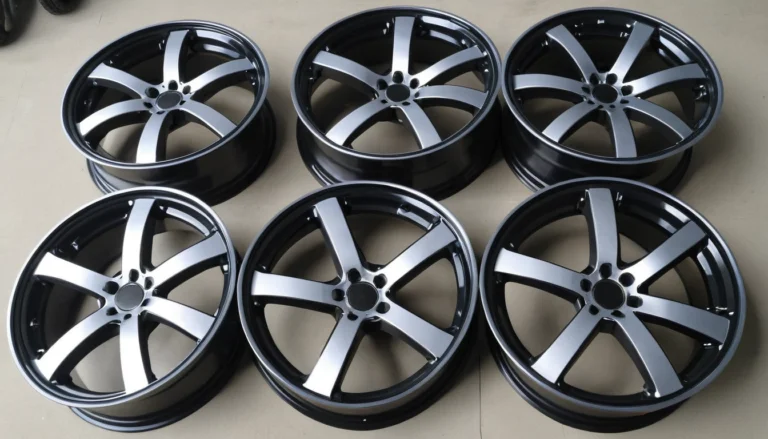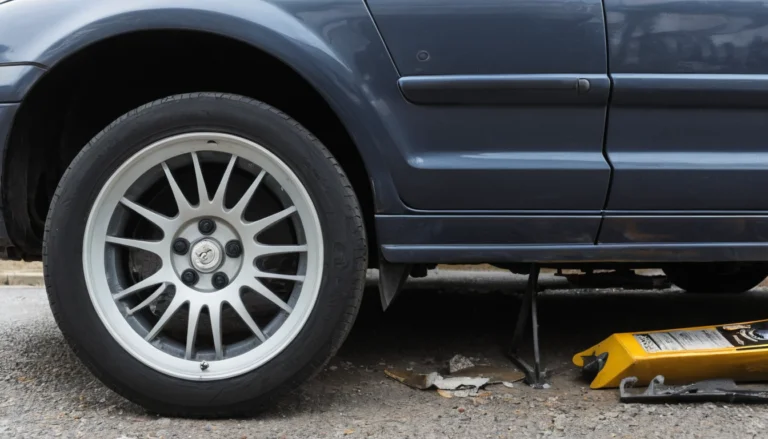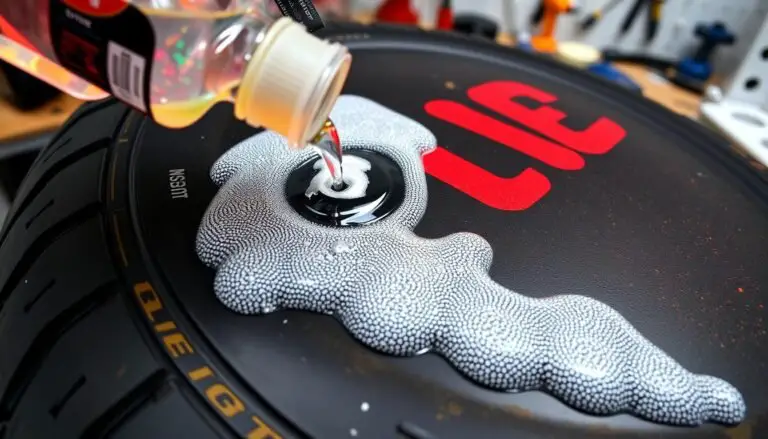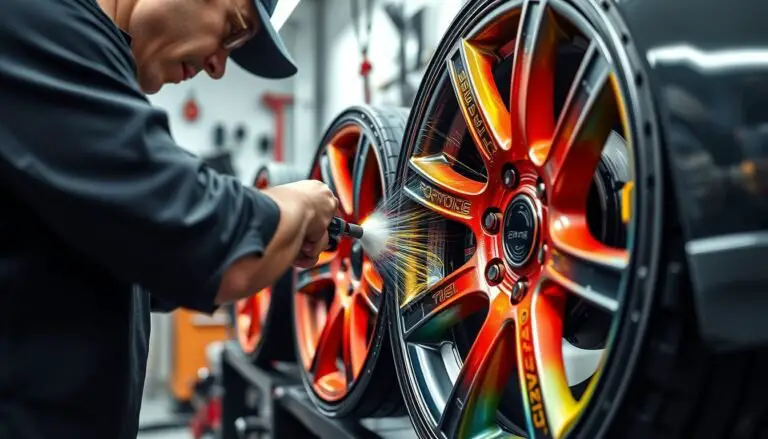How to Change Rims on a Car Yourself? Easy Guide
Changing your car’s rims can be a fun and cost-effective DIY project. It’s a great way to enhance your car’s look, boost its performance, or keep your tires and wheels in top shape. This guide will show you how to swap out your car’s rims step by step. We’ll cover everything from why rim maintenance is key to picking the right size and offset for your vehicle.
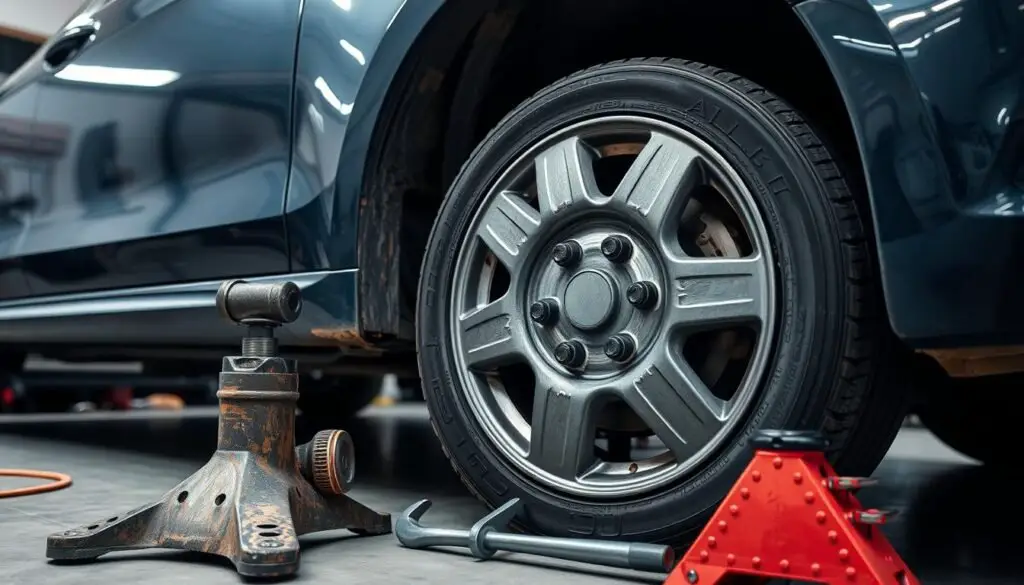
Key Takeaways
- Discover the impact of proper rim maintenance on your car’s safety and performance
- Learn about the cost savings of DIY rim replacement compared to professional services
- Understand the essential tools and materials needed for a successful wheel swap
- Explore step-by-step instructions for safely removing and mounting new rims
- Discover tips for selecting the right rims for your vehicle’s size and offset requirements
Importance of Proper Rim Maintenance
Keeping your vehicle’s rims in good shape is key for safety and performance. Proper tire and rim maintenance ensures your tires are always at the right pressure. This reduces the chance of blowouts and makes your car handle better. Plus, changing your rims yourself can save you a lot of money compared to getting a professional to do it.
Impact on Safety and Performance
Good rims are essential for your car’s safety and how well it performs. When your tires are properly inflated, thanks to automotive rim installation, they grip the road better. This means you can brake and turn more smoothly, making your drive safer and more enjoyable. If you ignore your rims, your tires will wear out unevenly, use more fuel, and handle worse.
Cost Savings of DIY Rim Replacement
Choosing to economical wheel upgrades by doing it yourself can save you a lot of cash. With the right tools and a bit of practice, you can easily swap out your old rims for new ones. This keeps your car looking and running its best.
“Proper rim maintenance is a simple yet essential aspect of vehicle care that can have a profound impact on safety, performance, and your wallet.”
Tools and Materials Needed for Rim Change
Changing your car’s rims requires the right tools and materials. Whether you’re experienced or new to DIY, having the right items makes the process easier and more successful.
Here are the tools for rim change you’ll need:
- A reliable jack to safely lift your vehicle
- A lug wrench to loosen and tighten the lug nuts
- Wheel chocks to secure the vehicle and prevent it from rolling
- A torque wrench to ensure the lug nuts are tightened to the proper specification
- The new rims you plan to install
Also, it’s wise to have some extra materials ready:
- Brake cleaner or degreaser to clean the wheel hub and mounting surface
- Wheel bearing grease to lubricate the wheel bearings
- Anti-seize compound to prevent the lug nuts from seizing
- A valve stem remover to remove and replace the tire valve stems, if necessary
| Tool or Material | Purpose |
|---|---|
| Jack | Safely lifts the vehicle to remove the old rims |
| Lug Wrench | Loosens and tightens the lug nuts |
| Wheel Chocks | Secures the vehicle to prevent rolling |
| Torque Wrench | Ensures proper tightening of lug nuts |
| New Rims | The replacement rims you’ll be installing |
With all the right tools for rim change and materials, you’re ready to replace your rims with confidence and efficiency.
Step-by-Step Guide to Removing Old Rims
Changing your car’s rims can be a fun DIY rim replacement project. But, it’s key to do it safely and carefully. First, you need to remove the old rims before putting on the new ones.
Preparing the Workspace
Start by picking a clean, level, and well-lit area. Make sure the surface can hold your car’s weight. You’ll need tools like a lug wrench, jack, and wheel chocks to keep the car steady.
Safely Lifting the Car
Now, get your workspace ready. Position the jack under the right lift points, as your car’s manual says. Raise the car slowly, making sure it’s on jack stands before you remove the rims.
- Loosen the lug nuts, but don’t take them off yet.
- Put wheel chocks on both sides of the tires to stop the car from moving.
- Remove the lug nuts completely and put them somewhere safe.
- Carefully pry the rim off the hub, avoiding brake damage.
Remember, safety is most important when working on your car. Take your time, follow the steps, and make sure the car is well-supported during the diy rim replacement process.
Selecting the Right Rims for Your Vehicle
Choosing the right rims is key when upgrading or replacing them. The right rims can make your car look better and improve its safety and performance. You need to think about the size and offset of the rims.
Considerations for Size and Offset
The size of your rims must match your car’s wheel wells and tire clearance. It’s important to pick rims that fit your car’s make, model, and year for a good custom wheel fitment. The wrong size can cause rubbing, bad handling, and safety risks.
The rim offset is how far the mounting surface is from the wheel’s centerline. This is important for automotive rim installation because it affects how the wheel sits with the suspension. The right offset can improve your car’s handling, stability, and tire life.
- Check your car’s specs for the right rim size and offset range.
- Think about the look you want, as different sizes and offsets change your car’s stance and look.
- Get help from a trusted tire and wheel shop to pick the right rims for your car.
By carefully choosing the size and offset of your rims, you can get a perfect custom wheel fitment. This will make your car perform better and handle better.
How to Change Rims on a Car Yourself
Changing your car’s rims yourself can save money and be fun. It involves mounting the new rims and making sure they’re aligned and secure. It’s important to follow the right torque and tightening steps to avoid problems.
Mounting the New Rims
First, check that the new rims fit your car’s make, model, and year. Place the rim on the wheel hub, aligning the lug holes. Use anti-seize lubricant on the wheel studs to prevent rust and make installation easier.
- Lower the rim onto the hub carefully, avoiding brake damage.
- Hand-tighten the lug nuts in a star or criss-cross pattern to hold the rim.
- Double-check the rim’s alignment, making sure it’s centered and level.
Torque Specifications and Tightening Sequence
Applying the right torque is key for your rims’ safety and life. Check your car’s manual or the rim maker’s guide for the correct torque.
- Use a torque wrench to tighten the lug nuts in a star or criss-cross pattern to the specified torque.
- Check the torque again after a short drive, as it might need tightening.
- Check the lug nuts’ tightness during regular maintenance to keep the wheels secure.
By following these steps, you can change your car’s rims yourself. You’ll get better performance, safety, and a unique look.
Tire and Rim Maintenance Tips
Keeping your car’s tires and rims in good shape is key for safety and performance. Regular care extends their life and makes driving better. Here are some tips to keep your tires and rims in top condition:
- Tire Inflation – Always check your tire pressure and keep it at the recommended PSI. This improves fuel efficiency and grip.
- Tire Rotation – Rotate your tires as your owner’s manual suggests. This helps them wear evenly, making them last longer.
- Rim Inspection – Look for damage like cracks, dents, or rust on your rims. Fixing these problems early prevents more damage and keeps your tires secure.
- Lug Nut Tightening – Check and tighten your lug nuts regularly. Use the torque specs from the manufacturer. Tight lug nuts are crucial for your tire and rim’s safety.
By following these tire and rim maintenance tips, you’ll drive safer and more smoothly. Remember, a little time and effort in automotive rim installation and care can greatly benefit your vehicle’s health and performance.
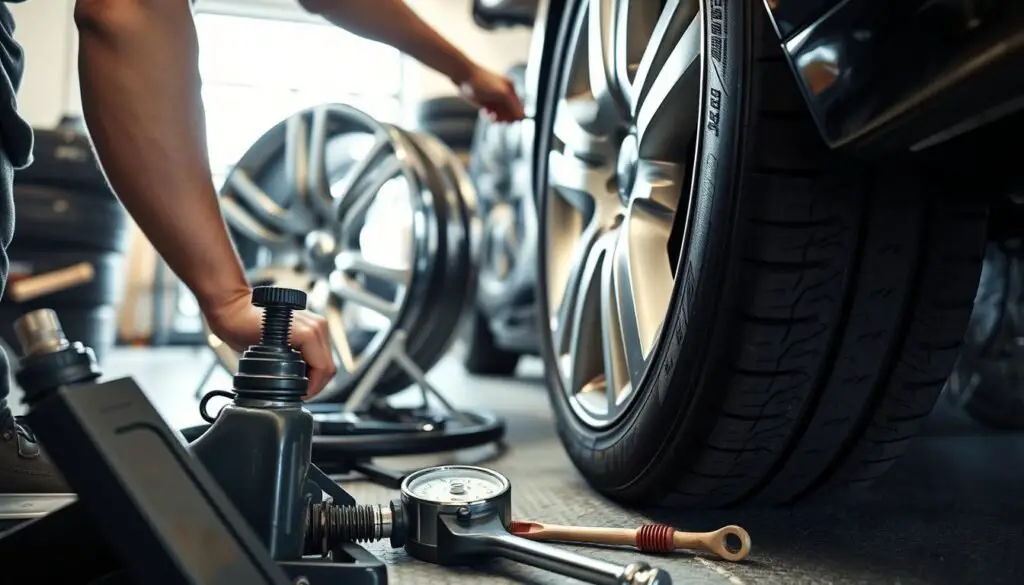
“Proper tire and rim maintenance is the key to unlocking your vehicle’s full potential on the road.”
Custom Wheel Fitment and Upgrades
Replacing your rims is just the start. You can also upgrade to custom wheels to make your car look unique. This is a great way to make your car stand out.
Enhancing Vehicle Appearance
Choosing custom wheel fitment can give your car a new look. You can pick wheels that match your car’s style perfectly. This creates a look that shows off your taste.
Going for economical wheel upgrades is a smart move. It lets you change your car’s look without spending a lot. You can find many styles, from sleek to sporty, to match your car.
“Upgrading to custom wheels can be a game-changer for your car’s appearance, allowing you to create a truly unique and personalized look.”
Looking for custom wheel fitment or economical wheel upgrades? There are many options. Finding the right wheels can change your car’s look and make a big impression.
DIY Rim Replacement: Economical and Rewarding
Changing your car’s rims yourself can save you money and give you a sense of pride. It’s a cost-effective project that lets you customize your vehicle. This way, you can make your car truly unique.
One big advantage of economical wheel upgrades is the cost savings. Getting a mechanic to replace your rims can be pricey. But doing it yourself means you only pay for the new rims, saving you a lot of money.
Completing a diy rim replacement project also brings a great sense of accomplishment. It’s a hands-on experience that teaches you new skills. You’ll learn more about your vehicle and save money on future repairs.
If you want to improve your car’s look or keep it running well, diy rim replacement is a smart choice. With the right tools and some guidance, you can upgrade your wheels affordably. This way, you get to enjoy the benefits of economical wheel upgrades that fit your style and needs.
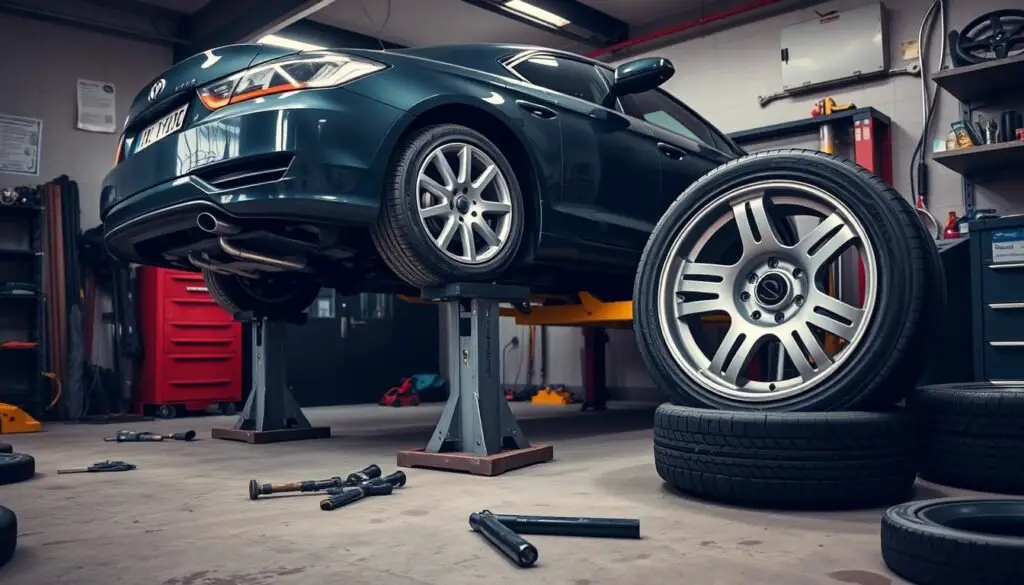
“Changing your own rims is not only a money-saving endeavor but also a satisfying way to personalize your vehicle and take ownership of its maintenance.”
Troubleshooting Common Issues
Changing your car’s rims can be a fun DIY project. But, it comes with its own set of challenges. We’ll look at some common problems you might face during a wheel swap guide. We’ll also give you practical tips to solve them.
Difficulty in Removing Old Rims
Having trouble with the old rims? First, make sure the lug nuts are completely loose. If they’re stuck, try a longer lug wrench or a cheater bar for more power. Old rims can also be rusted or corroded, making them hard to remove. A penetrating lubricant can help loosen them.
Improper Rim Fit
Choosing the right automotive rim installation is key. Make sure the new rims match your vehicle’s size and offset. Check the specs carefully to avoid any fit issues. If the rims are too big or have the wrong offset, they might not fit right or cause problems with your brakes or suspension.
Unbalanced Wheels
After putting on the new rims, you might notice the wheels feel off or vibrate. This could be from bad tire mounting or an unbalanced wheel. You can take your car to a professional tire shop for balancing. Or, if you have a wheel balancing machine, you can use that too.
| Common Issue | Possible Causes | Recommended Solutions |
|---|---|---|
| Difficulty Removing Old Rims | Stuck lug nuts Rusted or corroded rims | Use a longer lug wrench or cheater bar Apply a penetrating lubricant to break the seal |
| Improper Rim Fit | Incorrect rim size Wrong offset | Verify rim specifications match your vehicle Choose rims with the proper offset |
| Unbalanced Wheels | Improper tire mounting Imbalance in wheel assembly | Have the wheels balanced at a professional tire shop Use a wheel balancing machine if available |
Knowing these common issues and their fixes can help you confidently tackle the wheel swap guide. This ensures a smooth and successful automotive rim installation.
Conclusion
Learning to change your car’s rims yourself is a useful skill. It’s rewarding and can save you money. You’ll also get to enhance your car’s look and feel.
Doing it yourself lets you customize your car’s appearance. It’s also cheaper than hiring a professional. With the right tools and knowledge, you can do it successfully.
Changing your rims can improve your car’s look or keep them in good shape. The skills you learn from DIY rim replacement are valuable. You’ll be able to take care of your car’s maintenance and make it your own, saving time and money.
FAQ
What tools and materials are needed to change rims on a car?
To change your car’s rims, you’ll need a few key tools. A jack, lug wrench, and wheel chocks are must-haves. You’ll also need a torque wrench and the new rims. Having everything ready will make the process easier.
How do I safely lift the car when changing rims?
First, find a safe place to lift your car. Use wheel chocks to keep it steady. Then, follow the car’s manual to lift it with a jack. This ensures safety.
What factors should I consider when selecting new rims for my vehicle?
Choosing the right rims is important. Make sure they fit your car’s make, model, and year. Consider the rim size, offset, and bolt pattern for a perfect fit.
How do I properly mount and tighten the new rims?
Mounting new rims requires careful alignment and tightening. Use the correct torque and sequence to avoid problems. This ensures a secure fit.
How can I maintain my tires and rims to ensure their longevity?
Keeping your tires and rims in good shape is key. Regularly check inflation and look for wear or damage. Also, keep lug nuts tight for safety.
Can I upgrade to custom wheels to enhance the appearance of my car?
Yes, you can upgrade to custom wheels for a unique look. This can make your car stand out. It’s a great way to personalize your vehicle.
What are the benefits of changing rims myself instead of hiring a professional service?
Changing your rims yourself can save money and give you a sense of accomplishment. It’s a cost-effective and rewarding DIY project.
How can I troubleshoot common issues that may arise during the rim-changing process?
Common problems like removal issues or improper fit can happen. This section offers tips for solving these problems. It helps you overcome any challenges.


